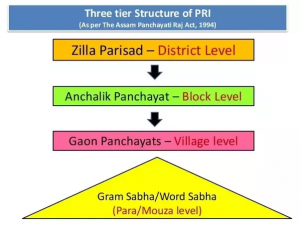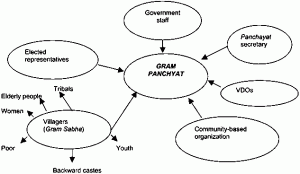Panchayti raj in Bihar
Act Formation
The Bihar Panchayati Raj Act was enacted in 2006 after the state was divided into Jharkhand and Bihar and a separate Panchayati Raj Department came into existence in 2007.
The Panchayati Raj Department
Th e Panchayati Raj Department (PRD) in Bihar came into existence in 2007. It mainly interacts with two ministries at the central level — the Ministry of Rural Development (MoRD) and the Ministry of Panchayati Raj (MoPR). PRD is considered an important department not only because of the quantum of funds that it handles but also because its activities have a direct bearing on rural development and poverty alleviation. It is also the nodal department through which attempts are made for grassroots democracy and decentralization of power through PRIs which have become the fulcrum of all development activities.
Reservation
Bihar was the first state in the country to bring in 50 per cent reservation for women in PRIs. This was made operational through the Bihar Panchayat Raj Adhiniyam, 2006. Accordingly, elections to PRIs which were held in 2006 had 50 per cent reservation for women and thus the total ERs had more women than men in the final tally.
Three-Tier Structure
PRIs at the district, block, and village levels are the Zilla Parishad, Panchayat Samiti, and Gram Panchayat respectively.
District Panchayat : Zilla Parishad
Intermediate Panchayat : Panchayat Samiti
Village Panchayat: Gram Panchayat
Gram Katchahary
Apart from the Gram Panchayat, the state has another institution at the village level called the Gram Katchahary which aims to bring justice to people’s doorsteps. The head of the Gram Katchahary is called the Sarpanch who is supported by the Gram Nyaya Mitra.
Support Structure
There are Panchayat Support Functionaries (PSFs) at all the three levels in the form of Standing Committees (SCs). At the village level there are seven SCs and at the district and block levels there are seven SCs each. The six SCs at the village level are:
- Planning, Coordination, and Finance Committee.
- Production Committee.
- Social Justice Committee.
- Education Committee.
- Public Health and Family Welfare Committee.
- Public Works Committee.
The seven SCs at the block and district levels are:
- General Standing Committee.
- Finance, Statistics, and Planning Committee.
- Social Justice Committee.
- Production Committee.
- Education Committee.
- Public Health, Family Welfare, and Rural Sanitation Committee.
- Public Works Committee.
As per a rough estimate, about 60–70 per cent of the SCs are functional at the district level, about 40–50 per cent at the block level, and very few are functional at the village level. Generally, there are very few SCs at the village level and almost none of them are functional.
Apart from SCs, there are also government functionaries who assist the Panchayats in carrying out their functions at each level.
7 IT/ICT/IT Enabled Infrastructure
Bihar is connected by the Bihar State Wide Area Network (BSWAN). All the blocks have access to computers and have Internet connectivity. Approximately 6,000 Common Service Centres are functioning at the village level; these are managed by Srei-Sahaj with the overall monitoring being done by Beltron. Under BRGF, the state has set-up a helpline for Panchayat systems and services. All the blocks have a facility for 2-way video conferencing. At the district level, PlanPlus Software is used for decentralized planning.
Overall Structure of CB&T Delivery
CB&T in the state is carried out for PRI representatives either directly through DPR or through the Bihar Institute of Public Administration and Rural Development (BIPARD). The training is imparted through a resource pool of Master Resource Persons (MRPs) and District Resource Persons (DRPs) developed by the department. The state recently revived nine Extension Training Centres (ETCs) called the ‘Mukhia Sarpanch Training Institutes’ (MSTIs) in Patna, Muzzafarpur, Darbhanga, Saharsha, Gaya, Munger, Bhagalpur, Purnia, and Sivan. BIPARD has plans of starting four ETCs in Patna, Bhagalpur, Purnia, and Muzzafarpur and the process of acquiring land for these at Purnia and Muzzafarpur is currently underway.
Programmes
A few programmes are directly related to the strengthening and capacity development of PRIs:
- The Bihar Panchayat Strengthening Programme (BPSP).
- Backward Region Grant Fund (BRGF).
- UNDP-Capacity Development of Local Governance (UNDP-CDLG).
- Shaktirupa.
The Bihar Panchayat Strengthening Programme (BPSP)
The World Bank funded a 5-year project for strengthening Bihar’s Panchayats with a grant of US$ 160 million. At the time of the field visit pre-project activities were being carried out for this project. These comprised of various research studies while project implementation activities were scheduled to begin in 2011. Some of the major activities under this programme are construction of buildings for Panchayats, training and capacity building, and research.
The programme has seven key components:
- PRI governance practices and capacity to manage local development.
- State, district, and block level resource centres.
- Grants for construction of PRI bhawans.
- Untied grants to PRIs to initiate development activities.
- Improving policies and the administrative environment in the state for effective functioning of PRIs.
- Performance monitoring and incentives for improvement.
- Project management and coordination.
Currently, it is envisioned that the project will be implemented in six districts, three of which are from the Kosi flood affected areas while the other three are Patna, Bhojpur, and Nalanda. PRD has requested an additional $120 million to enable the construction of Integrated Panchayat Buildings across the state. A separate society, the Bihar Gram Swaraj Society, has been formed for implementing this project.
Backward Region Grant Fund (BRGF)
The Backward Region Grant Fund is a special gap filling fund implemented by MoPR, GoI in 250 identified most backward districts in the country. This is being implemented in 36 districts of Bihar. Under this scheme, each district receives Rs 1 crore per annum towards capacity building activities which can involve CB&T infrastructure as well as implementing training.
UNDP — Capacity Development for Local Governance (CDLG)
MoPR is currently implementing the CDLG Project in seven states, including in Bihar with support from UNDP. CDLG is aligned with the goals and objectives of NCBF, and aims to strengthen institutions and processes at various levels so that a behavioral change can be brought about through increased motivation, joint decision-making, the provision of resources (that is, networks, resource persons/institutions, training courses/material, information, innovative solutions, and methods), and personal empowerment. The key partner institutions in this are training institutions, such as the State Institutes for Rural Development (SIRDs), the Panchayati Raj Training Institutes (PRTIs, existing in a few states), and Administrative Training Institutes (ATIs), which have the mandate to train ERs and offi cials in local governance.
Shaktirupa
Under the Panchayat Mahila Evam Yuva Shakti Abhiyan, an association for EWRs, called Shaktirupa has been formed which is registered under the Societies Registration Act, 1860. The main objectives of this society are building the capacity of EWRs and ensuring larger participation of women at the district as well as state levels.
BPCS Notes brings Prelims and Mains programs for BPCS Prelims and BPCS Mains Exam preparation. Various Programs initiated by BPCS Notes are as follows:-

